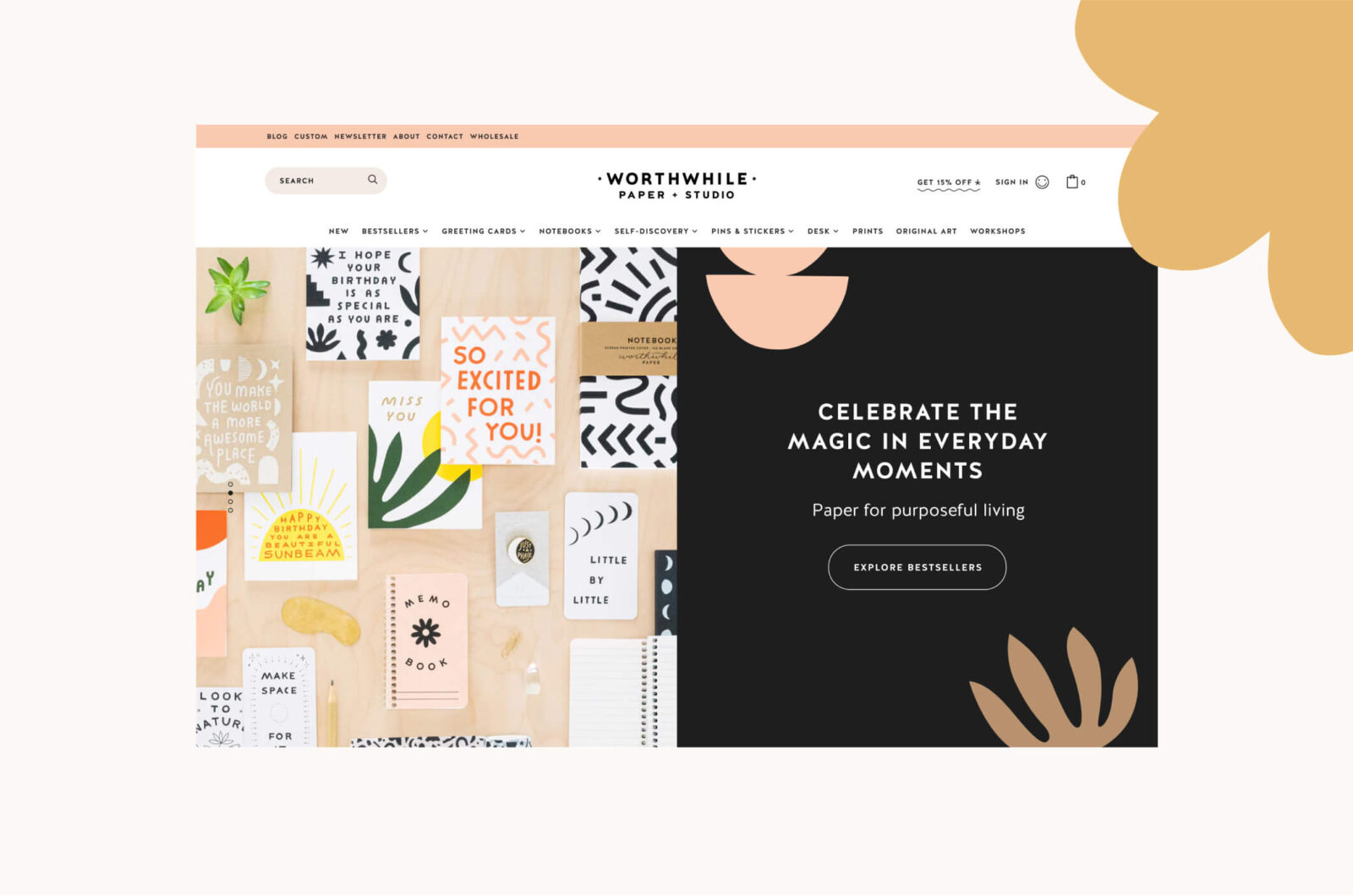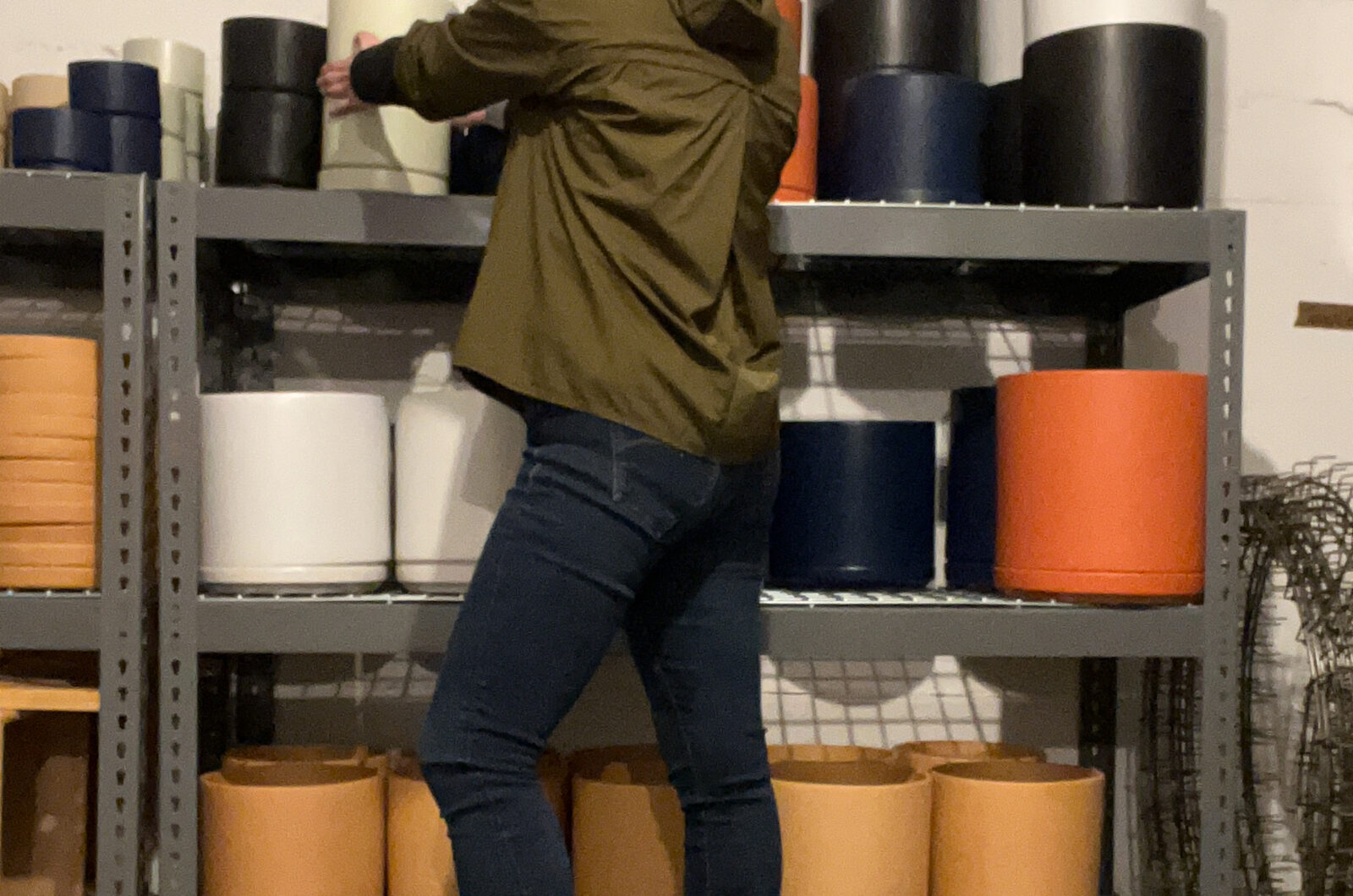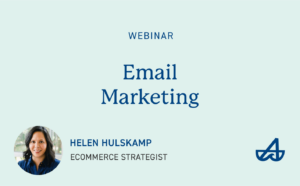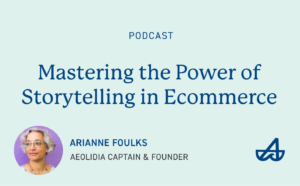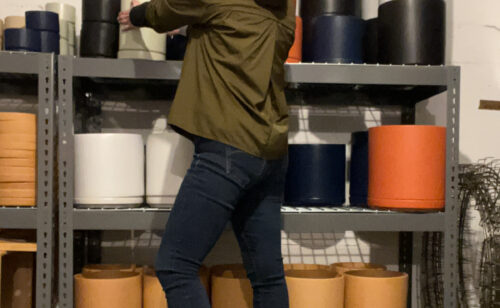
Welcome to the first of our brick-and-mortar Q&A series! Today we’re sharing some ideas for how to attract traffic to your store, and what else to stock beyond your own products.
Hi! I'm Katherine. I own a plant and flower shop with two locations in Tacoma, Washington called The Fernseed. We've been in business for three years and we have seven employees, including myself. It was a lifelong dream of mine to own a brick-and-mortar shop. I truly believe that independent storefront businesses are an indelible part of what makes a town or city a real "place." But running a shop, especially in the past few years, has been incredibly challenging. I found that there weren't a lot of resources available brick-and-mortar retail business owners — at least not ones that were honest, actionable, and not written by a software company trying to convert us into customers. So I started writing a Substack about my experiences called Storefront Revolt in an effort to create community (and bonus: get some things off my chest). Before I opened my shop, I actually worked for Aeolidia. So when I started writing Storefront Revolt, Arianne reached out to me about writing more brick-and-mortar focused content for Aeolidia readers. She and I both knew that while the majority of Aeolidia's audience is focused on e-commerce, there still are a lot of us running storefronts, and we could really use some support right now. I thought it would be fun to approach this in a Q&A format, so Arianne recently asked readers to submit questions, rants, or topics for discussion specifically related to storefront businesses. (And wow, what a response!) Each month I'll post a Q&A in response to one of your submissions, so please keep them coming.
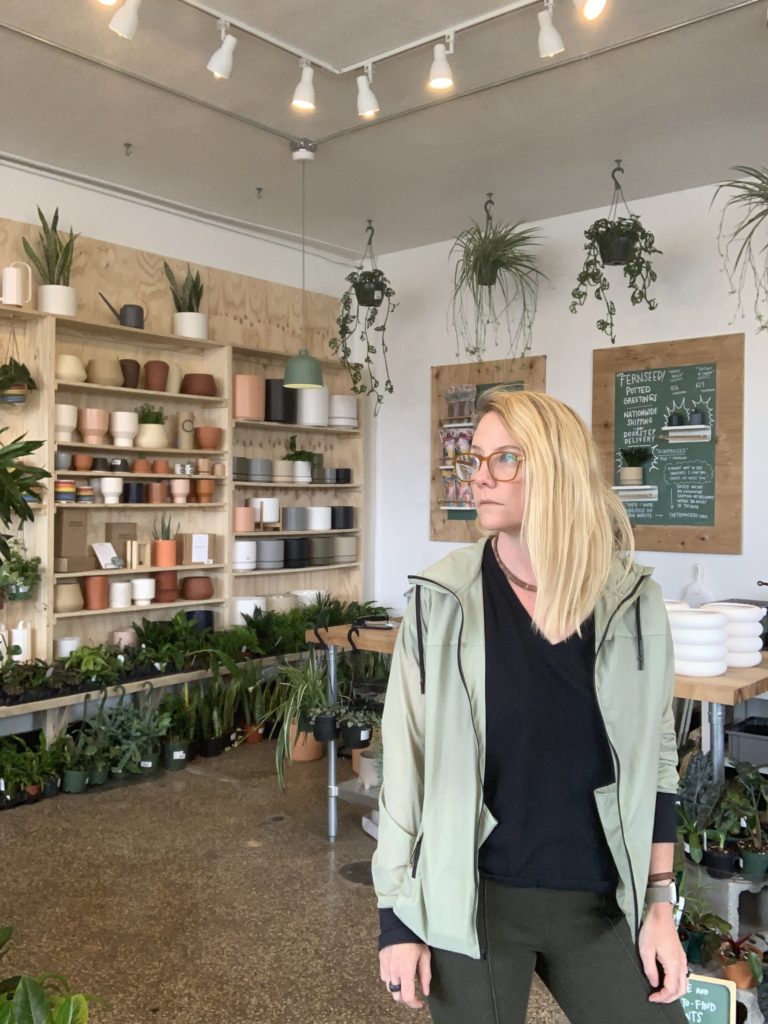
Brick & Mortar Question of the Month!
We currently have a small storefront attached to our production studio, in a (kind of!) junky old mill building. We’ve always wanted to have a proper brick and mortar shop, so when this space opened up we snagged it as a way to test the waters without jumping into and committing to a more traditional storefront right away.
Pain points:
Our “studio shop” is in a random part of the city that gets zero foot traffic and zero “hey I was just driving by and decided to stop in!”-type customers. As a result, we’ve only been open on planned days: every Saturday during December! Valentine’s Day weekend! etc. We have enough of a local brand following that people pay attention to when we’re opening, and will intentionally drive the 20, 30, even 60+ minutes to see us when we are open, but that’s good for justifying maybe being open once or twice a month, max… which, hey, if that’s what the reality is for this location, totally fine… but I’d love some thoughts on how to maximize traffic during the day/days we are open.
As mentioned above, since people are going out of their way to come to the shop (many times from out of town) I want to make their shopping experience special when they do come. We’ve got our entire product line in store, and I recently started adding complementary products from other brands to the mix. Our super sporadic hours, customers, and lack of real in-store purchase history (we just opened in December 2021) make it hard to know what other items (and how much) to buy, so I’ve been very conservative with how much other “stuff” we bring in, since we don’t want to be stuck with a ton of extra inventory. Would love thoughts on how to strategize buying for a shop in general, especially for shops that currently sell only their product/brand and are looking to supplement with complementary products.
Mary Swenson, Farm + Sea
Strategy For Buying Products
I love this question. It combines two things I know a lot about: getting people in the door to an off-the-beaten-path location, and figuring out what inventory to carry. When I say, “I know a lot,” I don’t mean I’m an industry expert here. I just mean I’ve acquired the kind of wisdom that can only come from losing lots of time and money on something, especially where inventory is concerned. So let’s talk about inventory first!
For weekly tips like this, subscribe to our newsletter
"*" indicates required fields
The key to buying for a shop is to find the magic overlap of products you love (because your shop is a reflection of you) and products that fly off the shelves. This takes years of building your buyer’s muscle, and the only way to build it is by stretching it to the point where you feel a little pain. You’re going to make mistakes. Go easy on yourself. There’s a reason every retail shop has a clearance table.
You’re at an advantage here because you’re already selling mostly your own products. I’m sure developing those products takes a fair bit of research and intuition to understand what your customers will buy. Adding complementary products (assuming you mean products you buy from other wholesale sources and that you don’t make yourself) involves a similar process. Start by listening to what your customers are asking for.
For example, Fernseed shoppers used to ask all the time if we carried small bags of potting mix. For a while, my response was, “No, sorry, most wholesalers only package it in larger quantities.” Then after the 700th person asked, it occurred to me that the universe was hitting me over the head with something. Sell small bags of potting mix! So we designed custom small bags and mixed a potting soil blend in-house. Now we have a best-selling product that adds hundreds of dollars in revenue each month. Customers will very literally tell you what they want to buy from you, you just have to pay attention.
You said you’re looking for complementary products, which is smart. Choose products that go hand-in-hand with your current line, and don’t venture too far out of your wheelhouse. Fernseed is a plant and flower shop, but when we first opened I carried home decor and housewares that didn’t have anything to do with plants. I kid you not, we sold coffee mugs—coffee mugs!—and customers asked why these “plant pots” had handles and no drainage. So we stopped carrying mugs. But remember when I said my wisdom only comes from losing time and money on bad ideas? We recently remodeled one of our shops and I tried—again!—to sell mugs. They sat on the shelves for months, untouched. Our customers don’t buy them. So I’ve learned (the hard way) that we should only carry products that extend the experience of displaying and caring for plants and flowers. If you make soap and candles, you’ll probably find more success selling products like matchstick holders and soap dishes than you will selling tarot cards.
You said you’ve been conservative in your buying because you don’t want to be stuck with a ton of extra inventory. That’s smart! Inventory ties up cash that can otherwise be used for operational expenses or to pay yourself, so you don’t want to sink cash into inventory that isn’t selling. That’s basically like putting dollar bills inside ice buckets and storing them in a deep freezer (or trying to sell mugs to plant shop customers). However, every retailer has to hold a certain dollar amount in inventory, depending on the size of their shop, so the store looks inviting and converts shoppers into customers. The key is arriving at your “just right” inventory numbers, and to do that, you should track metrics.
You’ve heard of KPIs, right? KPIs are “key performance indicators,” or metrics you use to define success in business. The KPIs I use for inventory management at Fernseed are:
- Total inventory on hand (wholesale cost)
- Gross margin (as reported by Shopify)
- Total dollars spent on new inventory (purchases)
- Cost of goods sold (beginning inventory + purchases – ending inventory)
- Turnover rate (cost of goods sold ÷ average inventory)
- Stock-to-sale ratio (average inventory ÷ net sales)
(Quick note: “average inventory” is your beginning inventory + ending inventory divided by two.)
I recommend pulling inventory reports once per month.
Here’s a peek at Fernseed’s last 30 days:
- Total inventory on hand (wholesale cost): $78,283
- Gross margin (as reported by Shopify): 52.05%
- Total dollars spent on new inventory (purchases): $25,261
- Cost of goods sold (beginning inventory + purchases – ending inventory): ($89,878 + $25,261) – $78,283 = $36,856
- Turnover rate: $36,856 ÷ ($89,878 + $78,283 ÷ 2) = 0.44%
- Stock-to-sale ratio: ($89,878 + $78,283 ÷ 2) ÷ 68,307 = 2.46
To understand how healthy your numbers are, compare them to retail industry benchmarks. You can do a deep dive here and research metrics based on NAICS industry codes and what-not, but I usually find reliable benchmark data by Googling things like, “What is a good turnover rate for retail?”
If you know anything about retail benchmarks, you’re looking at our last two metrics and cringing.
- Turnover rate industry benchmark: 2-4% (ours: 0.44%)
- Stock-to-sale industry benchmark: Between 5-10 (ours: 2.46)
We stocked up on inventory to get ahead of supply chain issues, so we’re sitting on a lot of overstock at the moment. I’m working on getting those numbers back to where they need to be, but hey: at least I’m tracking them so I know what the issues are!
What I would like to start doing—and what I recommend for you—is to separate these numbers by category. Our plants sell way faster than our handmade ceramics, so it would be good to know a turnover rate for each. Similarly, you could separate your in-house products from your complementary products and pull a report for each.
Whatever you do, make the process as painless as possible by ordering from vendors with low or no minimum opening orders, or selling on consignment (I refuse to do consignment because I hate the paperwork, but my friend who owned a shop in Chicago swore by it and did it exclusively) so you don’t tie up too much cash in inventory experiments. If products don’t sell, return them (if possible) or discount them fast.

How to Attract Traffic to Your Store
Now let’s address the other part of your question: how to maximize traffic on the days you ARE open.
I ran a vintage pop-up market in Chicago from 2009 to 2012. Because we needed to find cheap space that could house 80-100 vendors on a weekend, we popped up in out-of-the-way locations, like your dusty old mill. A decade later I still have anxiety dreams about hosting markets where no one shows up, so you can bet figuring out how to drive traffic to weird locations was an absolute obsession of mine. That said, we regularly attracted 2,000+ shoppers to our events, so I can safely say I was pretty good at this.
Driving traffic to a retail location is a slightly different animal, but with Fernseed, I’ve developed a two-point methodology around it.
- Give old customers new reasons to visit
- Give new customers old reasons to visit
In other words, you want to attract repeat customers back by offering something new and enticing, and you want to repeat the same strategies to get new customers in the door. Let’s look at some tactics for each.
Giving your returning customers new reasons to visit
- We all know the benefit of building an email list, but have you considered building a text message marketing list as well? I always think of SMS marketing as being a little on the spammy side, but as an independent brick-and-mortar business, you have the benefit of a built-in trustworthiness. We started using SMS marketing at Fernseed about a year ago, and it’s much more immediate than email. Our SMS unsubscribe rates are typically lower than our email unsubscribes, in part because we send pretty awesome deals via text. We use Klaviyo to combine our email and SMS lists, and they integrate nicely with Shopify. We offer a 10% off coupon when people sign up to get texts from us in-store, as well as an SMS signup via our website, and we’ve grown our list to about 1,200 people in a year.
- Facebook events and Instagram countdowns are also ways to remind people about shop events. I’d reserve Facebook events for actual events (like classes and pop-ups), but you can use Instagram countdowns for things like new product launches or sales that coincide with your next open day.
- We also run regular day-of-the-week sales at Fernseed. Every Monday, 4-inch plants are 40% off at both of our locations, and Tuesday we do 20% off all in-store floral products. We’ve been doing this for more than a year, so visiting on Mondays and Tuesdays has become habitual for our customer base. This has not hurt our sales on other days, and it helps us move lagging inventory. You might think of doing something similar.
- We also recently implemented a birthday discount. When customers sign up for our birthday list, they get a coupon for 25% off their entire purchase the week of their birthday, and this helps us spread sales out throughout the year.
- We’ve had mixed success hosting classes and workshops, but they’re worth trying out. You can teach them yourself, or invite other artists (I’d rely again here on people with big marketing lists) to host something in your space. The bonus of hosting workshops and classes: you can post them to local event calendars and event search platforms. Depending on your level of tolerance for this kind of thing, hosting private parties might also help bring people in. As more offices go fully or partially remote, companies are looking for off-site team-building opportunities to bring coworkers together, and they now have unspent in-house free snack and team lunch budgets to spend. We have an inquiry form on our site about using our space for private events, and we get an occasional real estate office asking about terrarium building classes for their team. Might be worth a shot!
Evergreen ways for new customers to find you
- Hosting pop-ups is one way you can tap into someone else’s audience to pull in traffic. With the vintage market, we found that inviting businesses with a sizeable marketing reach of their own helped. I bet you follow a few artists or makers on Instagram with huge followings. Invite them to host a pop-up!
- Don’t forget the awesome power of map and search directories, like Google and Yelp (I hate Yelp, but it’s a necessary evil here). These engines are perfect for businesses with sporadic hours. My kids love this LEGO shop in Tacoma, but it’s only open a few hours a week. I always check Google for open hours, and this tiny shop (bless them) keeps them updated and accurate. Bonus: if you have an online shop, you can post your products directly to your Google My Business listing and they’ll show up in search results. We sell a lot of flowers this way (and it’s free!) to people who didn’t know we existed until they Googled “flower shop.” Here’s a great guide from BrightLocal on how to do that. (BrightLocal is a great resource for maximizing local search traffic, so dig in there — lots of good stuff.)
- Taking a cue from other off-the-beaten-path businesses: what about strategically placed signage on or near a main road? I’m thinking about estate sales here, or u-pick farms. People really do drive around rural areas ready to do whatever an interesting sign points them to, so you could DIY some very visible sidewalk or road signs that divert weekender driving traffic in your direction (yes, permits are an issue here sometimes, but you know your region best. Sometimes it’s easier to ask forgiveness rather than permission).
I’m a big fan of data and tracking, so I recommend defining some KPIs for any tactic you do try, then going back and measuring how each marketing effort worked. Similar to inventory tracking, data can help you decide how to best spend your limited time and dollars.
Enjoy the process!
If you’ve come up with any good ways to attract traffic to your store that we didn’t mention, please post those in the comments, and we can learn from each other.
Got a brick-and-mortar question or challenge you’d like to see addressed in a future post? Submit it here.
How to run a successful brick & mortar shop
How do you run a retail shop that prices right, treats employees well, is community-minded, and still makes a profit? Watch our webinar, as five shop owners discuss how they’re running their businesses in this economy.
Brick & Mortar Economics 2022

How do you run a retail shop that prices right, treats employees well, is community minded, and still makes a profit?
Related Posts
Let's take your online shop to the next level
The Shopify websites we design have a reputation for substantial improvements to ecommerce conversion rates and online sales. Let's talk!

